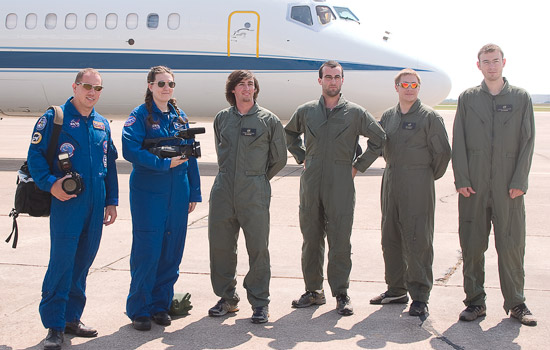Found in Space
RIT grads pursue rewarding careers at NASA
Kelly Downs
Preparing to ride NASA's Space shuttle
John Glenn, Eileen Collins and Rochester’s Pamela Melroy are among the public faces of space exploration. It takes the dedication of thousands, many who work inconspicuously, to support these astronauts and their flights.
RIT alumni at NASA’s Johnson Space Center in Houston are part of the team making those missions possible.
Graduates first launched careers at Johnson Space Center more than 20 years ago and the RIT family there has steadily grown. NASA recruiters visited campus in 1987, hiring seniors Mark Sowa ’87 and Sheri Dunnette Locke ’87, both from the imaging and photographic technology program in the College of Imaging Arts and Sciences.
Sowa heads the six-person Imagery Acquisition Group. No two days are alike. Their daily photo assignments may include taking group and individual astronaut portraits, shooting aerials for the U.S. Coast Guard, documenting participants on the “Vomit Comet” (related story), shadowing astronauts at water survival training in Pensacola, Fla., and shooting photos and video of a parachute drop test in Yuma, Ariz., for NASA’s Constellation program.
“I tell my staff what they see through their viewfinders is what will be seen by historians for generations to come,” says Sowa. “We always wonder, ‘What if Christopher Columbus had a photo staff?’ Imagine the images that would have been captured – the building of the ships, the cargo, and the journey itself. Our jobs are no different as we document this great effort of space exploration.”
Locke also started as a photographer, but is now part of the astronaut office in the information technology group. She is an IT lead who ensures that the astronauts have the computers and software they need while training for space flight. Her office also assists the astronauts in culling the photos they shoot in space.
“They don’t have time while on orbit to do it themselves so we pick out their best images,” says Locke. “It’s my goal to make their jobs easier. The astronauts work so hard and put in so many hours. It’s important for me to make it as easy as possible to help them be productive.”
Even though Locke no longer shoots fulltime, making images is still a passion. She is certified to fly as a backseat photographer aboard NASA’s T-38 jets shooting air-to-air photographs.
Imagery obtained in space is the focus of recent graduates from RIT’s imaging and photographic technology program.
Steve Marchiando ’97, Paul Reichert ’01 and Katrina Willoughby ’04 train the astronauts to use the cameras and video systems on board the space shuttles and International Space Station (ISS).
Marchiando and Willoughby support flights to the International Space Station and Reichert works with the crews on the shuttle missions. As part of the Photo TV Group, they teach classes, write the crews’ procedures and support the flights while in orbit. Their preparations begin 18 months prior to a scheduled mission.
“The training is a huge job,” says Reichert. “We teach 70 to 80 imaging classes for each mission’s training flow. We’ll add sessions if any of the astronauts needs extra training. We spend a significant amount of time with the crews.”
When one of the remaining orbiters in the fleet – Discovery, Endeavour or Atlantis – flies to the International Space Station, there is only one opportunity to photograph certain vantage points of the shuttle during the rendezvous. It’s at this time that the shuttle does a back flip, allowing the crew to photograph critical thermal protection surfaces.
“The International Space Station crew takes photos and documents all degrees of the orbiter,” says Willoughby. “We teach them how to do photo documentation when the shuttle flips over, what is called an R-bar pitch maneuver. Their window to get those images lasts just six minutes. It’s a very nerve wracking event because it could potentially be the safety of their friends going home on that orbiter.”
Examining those images to determine if there is potential damage is where the expertise of Robert Scharf ’94 (imaging science) and his team in the Image Science & Analysis Group is called upon.
Scharf supports the daily operations of the ISS with ISS exterior imagery analysis support and is called in to consult on imagery if there are any anomalous concerns on the exterior of the ISS. When one of the shuttles is in flight, his role changes.
“I wear a different hat,” says Scharf. “I’m managing the receipt of imagery, making sure it gets to our labs, and then reporting results of the analysis back up to management. So I become a focal point of communications during the mission.”
Scharf’s group was created as a result of the 1986 Challenger accident. On the day of a shuttle launch, his team gathers in the laboratory to watch the launch in real time and then on high-speed films running at up to 400 frames per second, looking for anything abnormal.
Scharf, of Horseheads, N.Y., came to Johnson Space Center in 1995. On his first day, he found himself in a meeting with Eileen Collins, the first woman to pilot a space shuttle, who grew up in nearby Elmira, N.Y.
“We were reviewing technical photos taken after her shuttle mission to the Russian space station Mir,” says Scharf. “Here I was sitting behind Eileen and just a month before I was at my parents’ house, watching the mission on television, knowing I was coming to work here, but not knowing what it would all be about.”
Adds Reichert, “When you first start out you are a little star struck because it’s like ‘Wow, this person flies in space.’ After a while though, they become your colleagues and your friends. They are helping us and we are helping them. We are all trying to reach the same goal.”
















